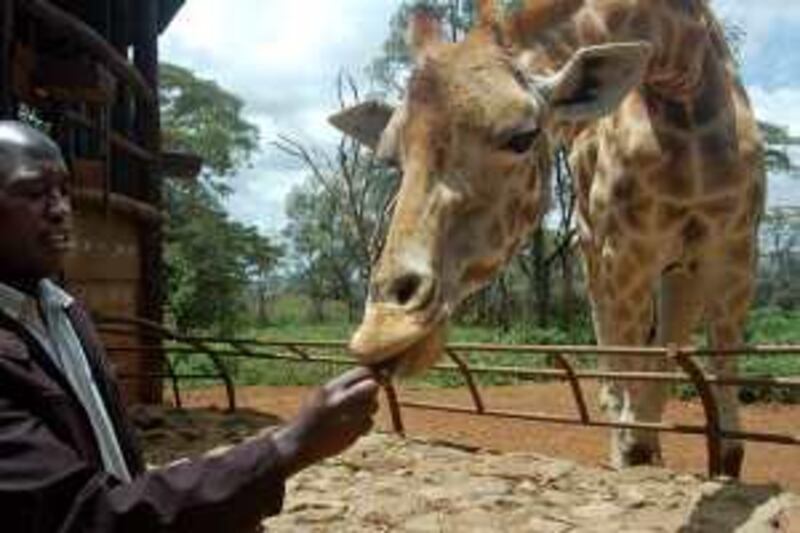NAIROBI // The mountain gorilla. The black rhino. The chimpanzee. These are the African animals most people think of as endangered. But a species of giraffe is actually one of the most vulnerable animals on the continent. Only about 300 Rothschild giraffes, the tallest of the majestic creatures at a height of more than six metres, are left in the world. The number is up from a low of about 120 in the 1980s, but the continued human-wildlife conflict in Kenya is again threatening the species. Another two species, the reticulated giraffe and the Maasai giraffe, are common throughout Kenya.
In the quiet, leafy Nairobi suburb of Langata, the Giraffe Centre has been fighting to save the Rothschild giraffe from extinction for three decades. The team of conservationists protects and breeds the animals to increase the population and educates Kenyan schoolchildren to ensure the species' continued survival into the next generation. Betty Leslie-Melville, an American who married a British-Kenyan, discovered that the Rothschild giraffe was nearly extinct in 1979. Only a few dozen were left in an area of western Kenya that was scheduled to be divided up into plots and sold to farmers. Mrs Leslie-Melville and her husband, Jock, brought two giraffes to their property in Nairobi and started the African Fund for Endangered Wildlife.
The Rothschild giraffe's normal habitat is in prime agricultural land in western Kenya and Uganda, and they have been all but squeezed out by human encroachment. The giraffes that are bred at the centre are relocated to protected wildlife sanctuaries across Kenya. "This giraffe took a beating," said Christine Odhiambo, the manager of the Giraffe Centre. "They were not welcome in the agricultural zone."
Poaching is also threatening the species these days. Semi-nomadic people hunt the giraffes for meat and use the skin to make crafts to sell to tourists. The Rothschild giraffe has a distinct orange-brown patchwork of geometric spots separated by pale lines, making its hide resemble a piece of dry, cracked earth. Humans are its biggest predator, although large cats can take down a baby. A few weeks ago, a leopard killed a young giraffe at the centre.
The eight giraffes here on the 100-acre preserve roam free and forage for leaves from the local acacia trees. Giraffe Manor, on the same grounds as the centre, is a unique hotel where guests can feed giraffes through their bedroom window. The animals also usually poke their heads into the dining room as guests eat breakfast. "The giraffes are gentle and they do well with people," said Ms Odhiambo. "It is a good chance to teach about conservation."
Every school day the centre busses in children from Nairobi slums and teaches them about the giraffes, the environment and conservation. To date, the centre has educated about 20,000 students. They also train teachers on how to incorporate conservation into their lesson plans. For seven-year-old Bernard Kamau, who visited the centre with his primary school class on a recent afternoon, the giraffes were the first wildlife he had seen up close.
"I like the long tongue," he said after feeding one giraffe. "It's slimy." The centre also sponsors an environmental art and essay writing contest among schoolchildren and takes kids on tree planting trips. Teachers hope this environmental education makes them understand the value of conservation. "It is about reaching out to underprivileged children," said Joseph Lemiso, an education officer at the centre, as he popped cereal pellets into the mouth of a giraffe called Kelly. "This is the future of Kenya."
While there are many conservation organisations working to protect the more popular animals such as the elephant, lion and gorilla, the Giraffe Centre is the only one dedicated to the Rothschild giraffe. "Many people think the giraffe is not endangered," Ms Odhiambo said. "It is endangered. There are only 300 [Rothschild giraffes] left today. That is so little compared to the zillions of elephants out there. But nobody is working on the giraffe."
Giraffes that are bred at the centre have an 80 per cent survival rate once they are relocated to animal sanctuaries, Ms Odihambo said. This beats the 50 per cent survival rate of animals born in the wild. "The giraffes are surviving, and that means the programme has been successful," Mr Lemiso said. "The next generation of Kenyans is able to learn about this amazing animal." @Email:mbrown@thenational.ae





